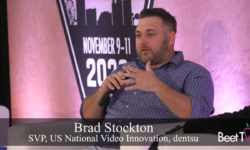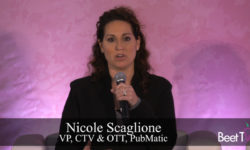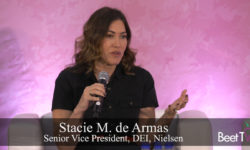SANTA MONICA — If it looks like the party is over for digital identifiers, the party is just getting started for true data about your own audience.
One solution to the deprecation of identifiers like cookies and IDFA is so-called “identity matching”, software which aims to stitch together available signals.
In this video interview with Beet.TV, René Plug, VP Corporate Development, TripleLift, says that can only ever be part of the solution.
Augment your matching
“Identity matching is under pressure,” Plug says.
“ID matching is very prominent, but it’s kind of not really in the spirit of these times. It’s very much a replication of third party cookie matching, which is just not really compatible anymore with current privacy standards.
“So it’s very clear that first-party data is going to be very important in a future strategy of any CTV publisher.
“If you augment your addressability strategy with first-party, then there is an immediate gain. You’re leaving money on the table if you don’t really engage with the topic today.”
The trouble with data
Indeed, the quest for “first-party data”, that supplied with consent by your own audience or customer base, has become the biggest in modern marketing.
As much as the decline of identifiers is a challenge, many marketers are reasoning, if it pushes the industry toward a future of opted-in, voluntarily-provided user sdata and a real relationship, more the better.
That’s the theory. The trouble? “First-party data is great but, most of the time, there’s not enough of it,” Plug says.
“Some publishers might have 10, 20, 30% of first-party data segments available. If you want to create scale, you have to have more than that.”
The two levers
There are three pillars of a successful post-cookie solution:
1. Cohort targeting
2. One-to-one targeting with login ID solutions…
…Want to know the third?
Tune in to find out!#thirdpartycookies #cohorttargeting #idsolutions #adtech pic.twitter.com/Sr0hHZw0Gl
— TripleLift (@TripleLiftHQ) November 25, 2022
TripleLift’s technology lets a brand can take a single set of creative assets and turn them into tens of thousands of unique native ads, each one tailored to each specific publisher.
It has also developed a host of new ad formats for TV companies.
Plug sees “two levers” for publishers to increase their first-party fortunes.
1. Maximise publisher addressability
“We use predictive technologies to actually scale up that small base of first-party data and scale it up to the entire inventory available to a publisher.
2. Cross-publisher reach
“That’s really where the big scale is. You’ve got make sure that there is standardisation. You want to have standard segments that multiple publishers support that you can actually buy consistently. You have to have collaboration. You have to have deals with all these different publishers.
“It’ll be very, very difficult for each and every advertiser to create all these different relationships. We’re now working very actively on building exactly that, a standardised transactable market, with multiple publishers based on first-party data.”
You are watching coverage of Beet Retreat Santa Monica 2022, presented by Ampersand, MiQ, Nielsen, PubMatic, T-Mobile Advertising Solutions and The Trade Desk. For more videos from the Beet Retreat, please visit this page.














































